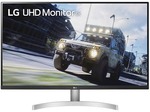My 5th Ozbargain Deal Post,.. Hope this one survives lolz
Considering some of the specs this monitor offers, I think not a bad price (unless there is something better out there?)
Been hanging out for a 32inch 4K monitor as it hits the sweet spot in size were one does not need to scale windows desktop bigger (cause hard to see font on a small 4K screen such as my current LG 27inch monitor Without scalling bigger)
Please do comment if this is worth the price offered by Kogan as will probably purchase one tonight
Noticed too,. Office Works sell the exact same specs LG 32inch 4K monitors, though theres have different model numbers, wonder if they'd price match with there "price match and 5% discount offer" with this 32inch 4K LG monitor from Kogan, might try them out today and report back here
The LG 31.5” UHD 4K HDR (32UN500-W) Gaming Monitor enables you to enjoy 4K HDR content as you've dreamed of
Boosts the new era of 4K HDR console gaming experience, not only bringing unprecedented thrills with decent image and sound, but also helping you win more battles with AMD FreeSync, Dynamic Action Sync and Black Stabiliser.
Speakers Wattage: 5W x2
Fluid and rapid motion,. with AMD FreeSync technology, console gamers can experience a seamless, fluid movement throughout high-resolution, fast-paced games. AMD FreeSync virtually eliminates screen tearing and stuttering.
React faster to opponents,. the Dynamic Action Sync feature minimises input lag so gamers can catch every single moment in real time.
Attack first in dark,. gamers can avoid snipers hiding in the darkest places and quickly escape situations when the flash explodes.
More vivid and realistic,. explore HDR content from multiple streaming services. The result is the truest with vivid colors in a wide range when playing on LG UHD 4K monitor with HDR10 technology in support of DCI-P3(D65) 95% (Typ.) colour space.
Easy and clean design,. the one-click stand makes it easy to install without any other equipment, and you can flexibly adjust the tilt of the big screen to position it in the optimal position desired by you
Specifications,..
Panel Type: VA
AMD FreeSync technology
Game Mode with Dynamic Action Sync
Dimensions: With Stand: 714.3 x 512.3 x 208.8mm | Without Stand: 714.3 x 420.0 x 45.7mm
Weight: With Stand: 7.8kg | Without Stand: 6.8kg
Display: Brightness 280 (min), 350 (Typ)cd/m²
Colour Gamut: Yes
Contrast Ratio: 1800:1 (min), 3000:1 (Typ)
Pixel/Dot Pitch 0.18159 x 0.18159 mm
Resolution 3840 x 2160 UHD 4K
Response Time 4ms
Screen Size 31.5"
Supported Aspect Ratios 16:9
Viewable Angle 178degree(R/L), 178degree(U/D)
Surface Treatment: Anti Glare
PIP: Yes
Black Stabiliser: Yes
Flicker Safe: Yes
Reader Mode: Yes
Wall Mountable: 100 x 100mm
Headphone Jack: Yes
Input Voltage: 100~240V (50/60Hz)
Power Consumption: 55W (Max), 45W (Typ), 0.5W (Sleep Mode), Less than 0.3W (DC Off)
Manufacturer Warranty: 3 Years
More specs from manufacturer
3-Side Virtually Borderless Design
Vivid Color & HDR
DCI-P3 90% (Typ.) HDR10
Multimedia Features
AMD FreeSync™
MAXXAUDIO®
Actually this is being offered at LG website in America for US$329.99, funny the warranty is only stated for one year?
https://www.lg.com/us/monitors/lg-32un500-w-4k-uhd-monitor




FYI, this is VA panel.